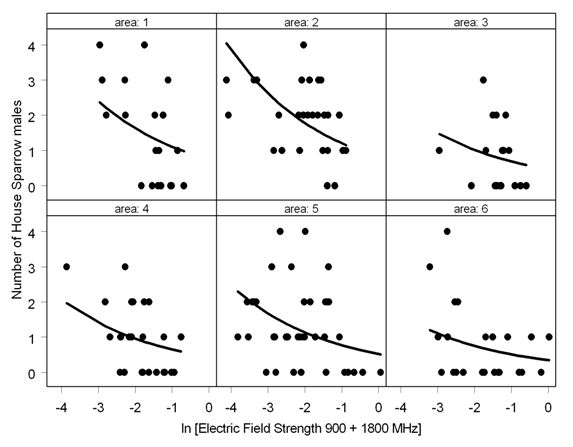A possible effect of electromagnetic radiation from mobile phone base stations on the number of breeding House Sparrows (Passer domesticus) |
Joris Everaert and Dirk Bauwens (Research Institute for Nature and Forest - www.inbo.be) published in Electromagnetic Biology and Medicine, 26: 63-72, 2007 Click here to download the full paper
Abstract: A possible effect of long-term exposure to low-intensity electromagnetic radiation from mobile phone (GSM) base stations on the number of House Sparrows during the breeding season was studied in six residential districts in Belgium. We sampled 150 point locations within the six areas to examine small-scale geographic variation in the number of House Sparrow males and the strength of electromagnetic radiation from base stations. Spatial variation in the number of House Sparrow males was negatively and highly significantly related to the strength of electric fields from both the 900 and 1800 MHz downlink frequency bands and from the sum of these bands (Chi²-tests and AIC-criteria, P < 0.001). This negative relationship was highly similar within each of the six study areas, despite differences among areas in both the number of birds and radiation levels. Thus, our data show that fewer House Sparrow males were seen at locations with relatively high electric field strength values of GSM base stations and therefore support the notion that long-term exposure to higher levels of radiation negatively affects the abundance or behaviour of House Sparrows in the wild. Click here to download the full paper Below is the Figure 1 from in the paper, and two additional Figures (2, 3).
Figure 1. Scatterplots of the observed number of House Sparrow males as a function of the sum (Egsm) of GSM 900 MHz and GSM 1800 MHz electric field strength values (logarithmic scale) at the different locations within each of the six study areas. Regression lines were obtained by Poisson regressions and incorporated the effects of area and radiation intensity (see text).
Figure 2. Scatterplot of the observed number of House Sparrow males as a function of the sum (Egsm) of GSM 900 MHz and GSM 1800 MHz electric field strength values (logarithmic scale) at the different locations (all 150 locations of the six study areas together). Regression lines (for each study area) were obtained by Poisson regressions and incorporated the effects of area and radiation intensity.
Figure 3. Mean number of the observed House Sparrow males (± std.error) as a function of the sum (Egsm) of GSM 900 MHz and GSM 1800 MHz electric field strength values (classified in groups) for the different locations (all 150 locations of the six study areas together).
|




